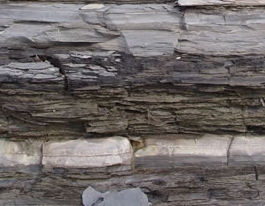
January Editorial
An Unconventional Oil and Gas Reservoir

January Editorial
An Unconventional Oil and Gas Reservoir
|
Shale is a fine-grained sedimentary rock formed from mud. As such shale is classified in the category of rocks known as ‘mudstones’. This means that shale is a mix of flakes of clay minerals and tiny fragments of other minerals such as quartz or calcite. The difference between a typical mudstone and shale is that shale is formed in thin, brittle horizontal layers known as laminations.
|
The tendency of rocks to split into such layers is called fisility and it is this fisility which is shale’s distinguishing feature. Black organic shales are of special interest to geologists, because they are an important source of oil and natural gas. The black colour of such shales comes from organic matter which was deposited within the mud when the shales formed. This organic matter decayed with time and was transformed into oil and natural gas. | |
|
Because of the low density of natural gas and oil in shale, over time some gas and oil migrates out of the shale and rises until it is trapped within the pores of the overlaying rock structures for example, sandstone. This creates what is known as a "conventional reservoir" of fossil fuel. However, much of the oil and natural gas remains trapped within the shale because the pores in the rock are small and poorly interconnected. So, black shales with their rich organic material are an abundant source of natural gas and oil. However, tapping this source is another matter. A few years ago every geologist who studied the Appalachian Basin oil and gas reservoirs knew about the existence of the Marcellus Shale formation, but few cared. Today the Macellus Shale is a hot topic. This shale is a large subsurface, middle Devonian-age (397-385 million years ago) black shale which spreads beneath much of Ohio, West Virginia, Pennsylvania and New York. Small areas of Maryland, Kentucky, Tennessee, and Virginia also have underlying Marcellus Shale. In most places the Marcellus Shale is about a mile below the surface. Drilling down to it is expensive, and conventional drilling techniques had proven unproductive. This changed radically with the introduction of modern drilling methods where a long horizontal pipe is introduced into the shale. With the pipe in place, multiple fractures are created. Natural gas then flows through the new fracture network, allowing a large volume of shale to be drained by a single pipe. The video below explains this technique in detail. As a result of horizontal drilling, the Marcellus Shale is now a major contributor to the natural gas supply of the United States - large enough to be spoken of as a "super giant" gas field. But the story does not stop here, because underneath the Marcellus shale, there is even bigger layer known as the Utica Shale. Utica Shale also outcrops in the New York State. It covers most of the area of the Marcellus Shale, but continues beneath Lake Ontario and Lake Erie into parts of Ontario and Quebec. The Utica Shale formation was created in the middle Ordovician age, from sediments deposited in the warm seas of approximately 465 million years ago. The problem with the Utica Shale is that it is mostly much deeper than the Marcellus shale and the depth varies. For example, under eastern Ohio Utica is about 2000 feet below Marcellus, but within south-central Pennsylvania it drops to about 7000 feet below Marcellus. Nor is the thickness of the shale uniform. In some places it is less than 100 feet in depth, while in other places the thickness reaches over 500 feet. However, if all of Utica can be utilized commercially, it would be geographically larger than any natural gas field known today. | |
| _______________________________ | ||||
| Home | | | Shopping | | | Database |
© Biscuit Software 2004-2015
All rights reserved